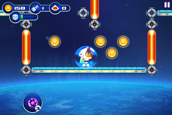
It's very frustrating to play a game when you no idea who your character is and what you should do with him.
The snobbishly proper term for when a developer throws you into the events of a game without establishing backstory is in medias res, and it can be an effective way to make the story authentic and compelling.
Space Disorder doesn't make use of in medias res. Instead, it simply starts without giving you a backstory, or any clue as to why you're in a spaceship. You're simply expected to hop about between platforms and make sense of things as you go along.
Mission controlIn fact, reading through the App Store description of Space Disorder is the only way to know that the game actually has a plot.
You play as the intrepid hero Noah, whose girlfriend Zanita was kidnapped by evil robots. Being intrepid, you take to the skies in an effort to rescue Zania along with a few innocent aliens who you also care about for some reason.
Knowing this made Space Disorder make a bit more sense, but it didn't make it any more fun.
This's mostly due to the simplistic nature of the gameplay itself. Space Disorder is, at its heart, a platformer that exists for the sole purpose of platforming. You tap to move and swipe to fly in a quest to collect coins as you progress through levels - and all of that works well - but without a clear sense of purpose it all seems hollow.
During your time in Space Disorder you'll have to dodge lasers and blow up the odd enemy or two with a grenade in your quest to free your girlfriend and her alien chums, but without proper context these challenges seem arbitrary.
With apologies to gravitySpace Disorder offers a lot of intriguing power-up to buy, along with the handful of costumes and a host of consumables.
You collect coins as you jump about the robot spaceship, and trade these coins in for the items you need to progress. Aliens are rescued by using a key (700 coins), and will give you missions once freed if you give them a couple of presents (300 coins each).
Each mission that you complete rewards you with a small number of Technical Points, which you use to buy upgrades like increased shield strength and new costumes, but these Technical Points are earned far too slowly in natural gameplay. To obtain them in a meaningful number you'll have to spend real money.
As frustrating as this payment mechanic is, the real frustration is the odd moments when Space Disorder offers you a glimpse of what it could have been.
There's an interesting mechanic whereby you can invert the gravity of a level and walk about on the ceiling, but you never have to make use of this ability. Were Space Disorder more of a proper puzzler, this gravity-inversion would make for a great gimmick, but in its current state it feels like a lonely feature included as an afterthought.
Heading to the black holeUltimately, it's difficult to recommend Space Disorder to anyone outside of the most dedicated of platform players. With zero-dimensional characters and simplistic gameplay, there simply isn't enough in the game to keep your interest for long.
That said, the graphics and music are both as cartoonish as they are solid - and the game is free and doesn't limit your playing time - so if you're looking for pure platforming without anything like 'plot' or 'story' to bog it down, Space Disorder might just be the game for you.
Space Disorder

